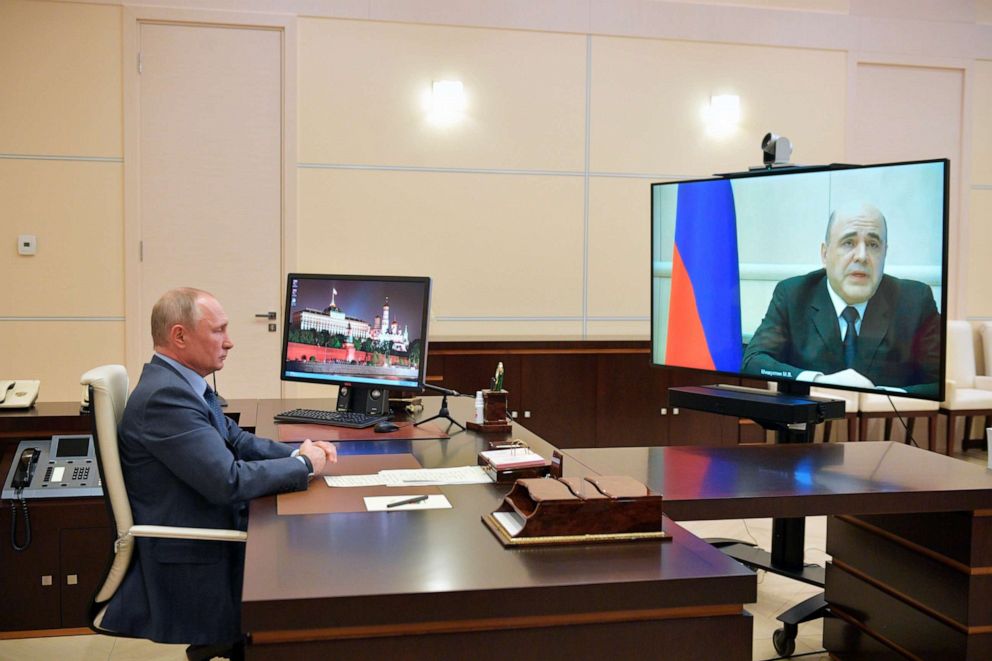Russia now second in the world for total coronavirus cases
The country nonetheless began easing lockdown restrictions on Tuesday.
Russia began to slightly ease its nationwide lockdown on Tuesday even as its number of coronavirus cases continued to grow, with the country overtaking Spain to become the second largest epidemic in the world behind only the United States.
Russia’s health ministry said the country now has 232,243 confirmed cases, following a week where it had been registering more than 10,000 new cases a day.
Highlighting the epidemic’s grip, President Vladimir Putin’s longtime spokesman, Dmitry Peskov, on Tuesday also said he had tested positive for the virus and was being treated in a hospital with his wife. Russia's prime minister Mikhail Mishustin has also already spent more than a week in the hospital after testing positive for the virus.
Seeking to allay fears that Putin himself could have been exposed, Peskov told the Russian news agency RIA Novosti that he had not met Putin in person for a month.
Despite that disquieting picture, Russia nonetheless on Tuesday formally began the first phase of easing its lockdown. A day earlier, Putin announced that regions from Tuesday could begin deciding when and how to lift the restrictions that have required businesses to close and non-essential workers to remain at home.
That directive means Russia will now likely see a patchwork of different levels of restrictions across its vast territory, as some regions slowly reopen. Others though are likely to remain under strict lockdown for weeks more.
In Moscow, for example, authorities have already extended the lockdown until May 31, although construction sites and factories can now return to work. In the city, which is home to more than half of the country's total COVID-19 cases, it is also now mandatory for people to wear masks and gloves in public spaces.

But other regions across Russia on Tuesday announced some small relaxations of restrictions. The most common step was to allow people to walk outside and do some sports. In some regions, particularly in Siberia and the far east, some malls and shops will be allowed to reopen, and in a handful of places, including the European enclave Kaliningrad and Kamchatka on the Pacific Coast, hairdressers can now work, although with restrictions.
People over 65 must remain in isolation regardless, Putin said, and all mass events remain canceled.
Despite the big daily numbers, Russian authorities have insisted there are signs the epidemic is stabilizing and the growth rate has slowed. Anna Popova, Russia's chief medical advisor on Tuesday said the number of new cases has been stable since May 3, fixed at around 10,000 new cases a day.
Russia’s health system remains under intense strain from the virus and health workers have been hit badly. Almost 70,000 people are currently hospitalized in Russia, according to Russia’s chief medical adviser, Anna Popova. In Moscow, hospitals treating coronavirus are still packed with patients, according to medics there.
In St. Petersburg, a fire in a coronavirus ward killed five patients on Monday, reportedly after a faulty ventilator caught fire.
Experts have also been trying to understand why Russia’s official death toll -- 2,116 -- is puzzlingly low. At around 13 deaths per million, it is far lower than the global average of 36 deaths per million and far less than other countries with a similar number of cases.
A possible explanation emerged on Sunday after Moscow's city government published data that suggested authorities may be substantially undercounting deaths. The data showed the total deaths registered in Moscow in April from all causes.
Some experts have suggested that such data in countries hit by coronavirus will show a spike in total deaths during the months of the pandemic compared to the total deaths recorded in the same period in previous years. That in theory could give a better picture of the real number of deaths caused by the virus. The Financial Times conducted an analysis using such data from 14 countries last month that suggested the real global death toll from coronavirus may be 60% higher than reported in official counts.
The new data published by Moscow’s city government showed there had been 1,841 more deaths in Moscow in April compared to last year, an 18% increase. That compares to the 658 deaths registered officially as caused by the virus in the city in April.
Experts and doctors in Russian hospitals have previously said they believe Russia’s official death toll is artificially low, noting that many coronavirus-linked deaths are being recorded under other causes.






